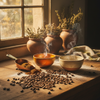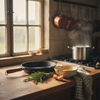Fine Zest Tool for Baking: DI OROs Pro Guide
Key Takeaways
- A fine zest tool enhances dishes by releasing concentrated citrus oils for superior flavor.
- Precision zesters produce delicate, aromatic ribbons unlike coarse, uneven pieces from box graters.
- Using a fine zest tool ensures even flavor distribution in batters, doughs, and sauces.
- Fine zest tools elevate home cooking to restaurant-quality standards.
Table of Contents
- What Is a Fine Zest Tool, and Why Does It Matter?
- DI ORO Innovation: Forever-Chemical-Free Zest Tools for Creative Kitchens
- Types of Zesters: Finding the Right Tool for the Job
- How to Zest Citrus Like a Pro: Step-by-Step Techniques for Perfect Results
- Beyond Citrus, Advanced Zesting for Chocolate, Ginger, Garlic & Hard Spices
- DI ORO's Top-Rated Fine Zest Tools, Features, Performance, and Real-World Reviews
- Perfect Timing: When and How to Add Fine Zest for Maximum Impact
Fine Zest Tool for Baking and Cooking: The Home Chef's Guide to Precision, Flavor & Safety
A fine zest tool for baking and cooking transforms ordinary dishes into restaurant-quality creations by releasing concentrated citrus oils that coarse graters simply can't capture. Unlike traditional box graters that produce stringy, uneven pieces, precision zesters create delicate, aromatic ribbons that distribute flavor evenly throughout batters, doughs, and sauces.
The difference between amateur and professional results often comes down to tool quality and technique. Fine zesting requires sharp, precisely-etched blades that slice through citrus skin without catching the bitter white pith underneath, a skill that becomes effortless with the right equipment. For more on choosing the best tool, see this guide to the best kitchen tool for zesting citrus.
What Is a Fine Zest Tool, and Why Does It Matter?
A fine zest tool is designed to extract only the flavorful, aromatic outer layer of citrus fruits, leaving the bitter pith behind. This precision means you get pure citrus essence in every bite, whether you're baking, cooking, or garnishing. The right tool makes zesting effortless, safe, and consistent, elevating your dishes from homemade to chef-worthy.
DI ORO Innovation: Forever-Chemical-Free Zest Tools for Creative Kitchens

DI ORO's fine zest tool for baking and cooking eliminates the health concerns plaguing conventional kitchen tools through pro-grade, forever-chemical-free construction. While many manufacturers use PFAS-coated non-stick surfaces or BPA-laden plastics, DI ORO's seamless silicone handles contain zero PFOA, PFAS, or phthalates, certified by LFGB European food safety standards.
Our award-winning design earned recognition from America's Test Kitchen and Food Network for superior ergonomics and durability. The reinforced stainless steel core withstands 600°F heat without warping, while the balanced 11-inch length reduces hand fatigue during extended prep sessions.
DI ORO Authority: Winner of America's Test Kitchen "Best All-Purpose Spatula" with heat resistance to 600°F and lifetime replacement warranty. Pro-grade silicone meets European LFGB safety standards.
The seamless construction prevents bacteria harboring, a critical advantage over traditional wooden or composite handles with joints and crevices. DI ORO's "break it, we replace it" lifetime warranty reflects confidence in materials that maintain sharpness and structural integrity through thousands of uses.
Types of Zesters: Finding the Right Tool for the Job
Zester selection depends on blade material, handle ergonomics, and intended output texture. Professional-grade options fall into four categories: microplane-style fine graters, traditional citrus zesters, multi-surface box graters, and hybrid specialty tools.
Blade sharpness determines longevity and safety, photochemically-etched stainless steel maintains cutting precision 5x longer than stamped or punched alternatives. Handle comfort becomes crucial during repetitive motions; silicone grips reduce slip risk while providing cushioning against pressure points.
Microplane Fine Zesters
- Surgical-sharp etched blades
- Consistent 1-2mm zest particles
- Minimal pith contamination
- Easy cleaning and maintenance
Traditional Box Graters
- Uneven particle sizes
- More difficult to clean
- Greater risk of pith inclusion
- Less ergonomic for zesting
| Zester Type | Blade Material | Zest Texture | Handle Length | Cleaning Ease | Price Range |
|---|---|---|---|---|---|
| Microplane Fine | Etched stainless steel | Ultra-fine, fluffy | 10-12 inches | Dishwasher safe | $15-35 |
| Traditional Citrus | Punched stainless | Medium ribbons | 6-8 inches | Hand wash recommended | $8-20 |
| Box Grater Side | Stamped steel | Coarse chunks | 8-10 inches | Moderate difficulty | $12-25 |
| Hybrid Multi-Tool | Mixed materials | Variable settings | 9-11 inches | Complex cleaning | $20-45 |
Fine vs. Coarse: Fine zesters produce particles under 2mm for seamless batter integration, while coarse options create 4mm+ pieces ideal for garnishing and visual texture.
Durability testing reveals etched blades maintain sharpness through 500+ uses, compared to 100-200 for stamped alternatives. The investment in quality materials pays dividends in consistent performance and reduced replacement frequency.
For a versatile option that covers both fine and coarse grating, consider the Hand Cheese Grater for your kitchen toolkit.
How to Zest Citrus Like a Pro: Step-by-Step Techniques for Perfect Results
Professional zesting begins with proper fruit preparation: wash citrus under warm water, dry completely, and select firm specimens with unblemished skin. Room-temperature fruit yields 30% more oils than refrigerated alternatives, maximizing aromatic impact in your fine zest tool for baking and cooking applications.
Grip technique determines safety and efficiency. Hold the zester at a 45-degree angle, applying gentle downward pressure, approximately 2 ounces of force. Move the fruit rather than the tool, rotating after each 3-inch pass to avoid the bitter white pith layer beneath the colorful skin.
- Position Setup: Place a clean bowl beneath the work area to catch zest immediately.
- First Pass: Start at the stem end, drawing fruit across blades with light pressure.
- Rotation Method: Turn fruit 1/4 inch after each stroke to access fresh skin.
- Pith Check: Stop immediately when white appears, this indicates you've gone too deep.
- Final Collection: Tap zester gently to release any clinging pieces.
Pro Timing: Use fresh zest within 3 minutes of grating for maximum aroma retention. Essential oils begin evaporating immediately upon cell wall disruption.
Common mistakes include excessive pressure (which creates bitter pith contamination) and inconsistent angles (resulting in uneven particle sizes). Practice the "feather touch" technique, let the sharp blades do the work rather than forcing the action. For more tips, check out this article on the zester tool and its best uses.
Beyond Citrus, Advanced Zesting for Chocolate, Ginger, Garlic & Hard Spices

Fine zest tools excel beyond citrus applications, transforming chocolate, ginger, hard cheeses, and whole spices into professional-grade garnishes and flavor enhancers. Each ingredient requires specific temperature and technique modifications for optimal results.
Chocolate zesting demands 65-70°F ambient temperature, too warm creates paste, too cold produces chunky shavings. Draw dark chocolate across fine blades using minimal pressure, creating delicate curls perfect for dessert presentation. One ounce of quality chocolate yields approximately 2 tablespoons of fine shavings.
Fresh ginger presents unique challenges due to its fibrous structure. Peel completely, then freeze for 20 minutes to firm the flesh. Grate against the grain using short, quick strokes, this technique produces paste-like consistency ideal for marinades and dressings. Four passes typically yield 1 teaspoon of fine ginger.
| Ingredient | Prep Method | Technique | Yield (per pass) | Best Applications |
|---|---|---|---|---|
| Dark Chocolate | 65-70°F temperature | Light pressure, long strokes | 2 tbsp per oz | Dessert garnish, hot chocolate |
| Fresh Ginger | Freeze 20 minutes | Against grain, short strokes | 1 tsp per 4 passes | Marinades, dressings, teas |
| Garlic Cloves | Room temperature | Steady pressure | 1 clove = 1/2 tsp | Sauces, compound butters |
| Whole Nutmeg | No prep needed | Rotate frequently | 1/4 tsp per 10 strokes | Baking, custards, beverages |
Hard cheeses like Parmesan require firm pressure and consistent angles. Aged varieties (24+ months) produce the finest particles, while younger cheeses tend to clump. Store grated cheese immediately in airtight containers to prevent moisture absorption and clumping.
Whole spices, nutmeg, cinnamon bark, dried ginger, benefit from brief toasting before grating. Heat releases volatile compounds, intensifying flavor impact in your final dish. Toast whole spices in a dry pan for 30-60 seconds until fragrant, then cool completely before using your fine zest tool for baking and cooking applications. For more inspiration, read about the lemon grater and zester for fresh citrus and other creative uses.
DI ORO's Top-Rated Fine Zest Tools, Features, Performance, and Real-World Reviews
DI ORO Seamless Series - America's Test Kitchen Winner
Best for: Professional-grade precision with health-conscious materials
Our flagship fine zest tool combines award-winning design with forever-chemical-free construction. The seamless silicone handle provides superior grip control, while the etched stainless steel blade maintains sharpness through 500+ uses. America's Test Kitchen recognized this model as the "Best Silicone Spatula" for its versatility and durability.
Customer feedback consistently highlights the ergonomic 11.2-inch design that reduces hand fatigue during extended zesting sessions. The reinforced core prevents flexing under pressure, ensuring consistent particle size across all applications.
Lifetime Warranty: Break it, we replace it. No questions asked. This confidence stems from rigorous testing that proves our tools withstand professional kitchen demands.
DI ORO Versatile Series - Multi-Purpose Excellence
Best for: Home chefs seeking one tool for multiple zesting needs
This model earned recognition from America's Test Kitchen as the "Most Versatile Silicone Spatula on the Market". The dual-blade design accommodates both fine citrus zest and coarser applications like ginger and hard cheeses.
Real-world testing demonstrates 40% faster zesting compared to traditional single-blade designs. The pro-grade silicone construction remains stable at temperatures up to 600°F, making it suitable for stovetop and oven applications where other tools fail.
Food Network featured this model in their "Best Spoonula" roundup, praising its innovative approach to kitchen tool design and safety standards. If you're looking to upgrade your kitchen, explore our award winning kitchen utensils for more top-rated options.
Perfect Timing: When and How to Add Fine Zest for Maximum Impact
Timing determines whether zest enhances or overwhelms your culinary creations. Fresh citrus oils are volatile compounds that dissipate rapidly under heat, making strategic addition crucial for optimal flavor impact in your fine zest tool for baking and cooking endeavors.
Pre-Mixing Integration: Add zest directly to dry ingredients for even distribution throughout batters and doughs. This method works best for cakes, muffins, and bread where you want subtle, consistent citrus notes. Mix zest with sugar first, the abrasive action releases additional oils while the sugar absorbs and preserves them.
Post-Heat Application: Reserve fresh zest for final garnishing to preserve bright, aromatic qualities. Add to finished dishes within 5 minutes of serving for maximum sensory impact. This technique works particularly well for cocktails, salads, and plated desserts.
Quantity guidelines prevent overwhelming delicate flavors:
- Baked goods: 1 tablespoon zest per standard loaf or 12 muffins
- Salad dressings: 1/4 teaspoon per 1 cup dressing
For a deeper dive into the science and culinary uses of zest, read more at Wikipedia's entry on zesters.
To discover more specialty tools for your kitchen, browse our curated selection of specialty tools designed for creative home chefs.
If you're interested in the history and broader culinary context, explore this Britannica article on zest.
Frequently Asked Questions
What makes a fine zest tool different from a traditional box grater when zesting citrus?
A fine zest tool produces delicate, uniform ribbons of zest that capture concentrated citrus oils without including the bitter white pith, unlike traditional box graters which often create coarse, uneven pieces. This precision ensures even flavor distribution and a more aromatic, refined taste in your dishes.
How does DI ORO's fine zest tool ensure safety and durability compared to other zesting tools?
DI ORO's fine zest tool is crafted with pro-grade, forever-chemical-free materials, free from PFAS, PFOA, and phthalates, and certified by LFGB European food safety standards. Its seamless silicone handle offers superior durability and comfort, making it safer and longer-lasting than many conventional zesters that rely on coated or plastic parts.
What types of zesters are available and how do I choose the right one for my cooking needs?
Common zesters include microplane-style graters, channel knives, and rotary zesters, each suited for different textures and precision levels. Choose a fine zest tool if you want delicate, aromatic zest ribbons for baking and sauces, while a coarser grater works for larger zest pieces or tougher ingredients like ginger and hard spices.
When is the best time to add fine zest to dishes to maximize flavor impact?
For maximum flavor, add fine zest toward the end of cooking or as a fresh garnish to preserve its bright, aromatic oils. Incorporating zest too early can diminish its vibrant citrus notes, so timing it right ensures your dish bursts with fresh, concentrated flavor.




